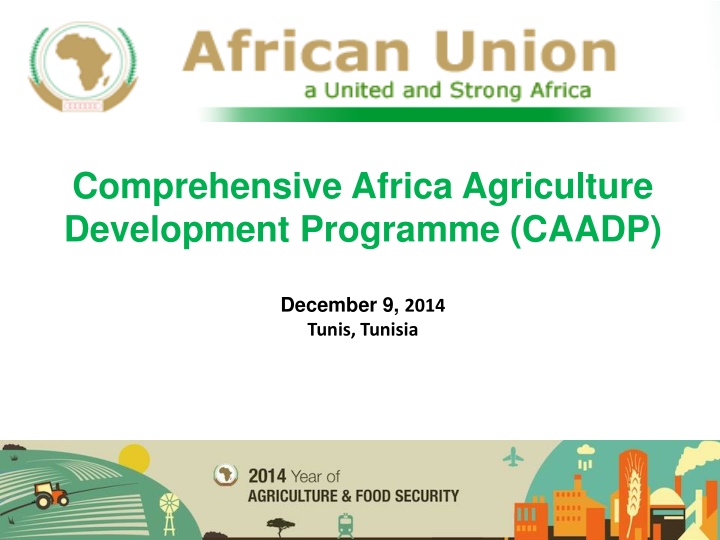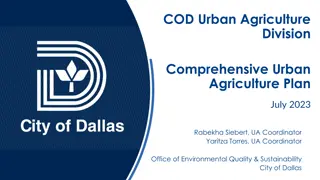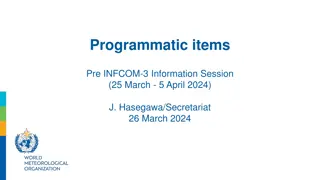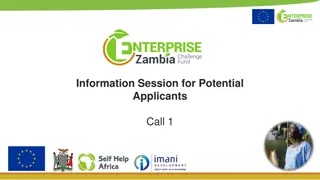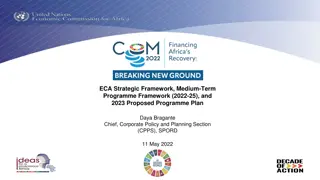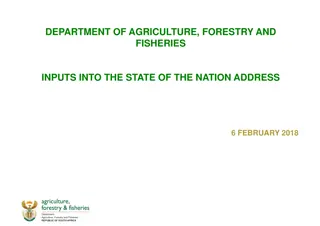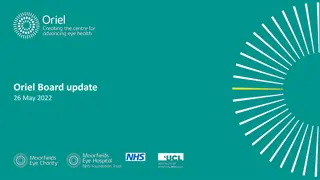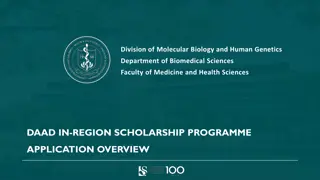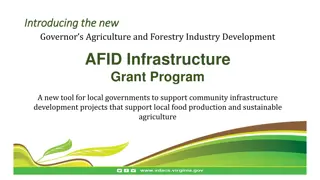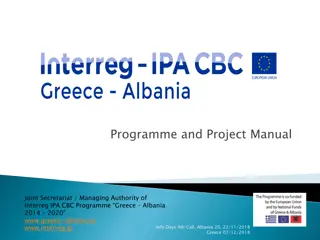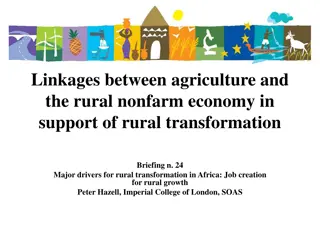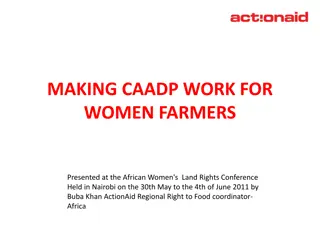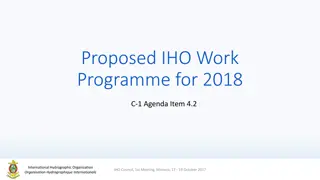Comprehensive Africa Agriculture Development Programme (CAADP)
CAADP is an African framework facilitating AU Member States' agriculture-led investment plans to enhance food security, eradicate hunger, reduce poverty, and stimulate economic growth. Initiated in 2003 through the Maputo Declaration, CAADP aims for at least 10% public investment in agriculture to achieve a minimum 6% annual Agricultural GDP growth. With 50 out of 54 states utilizing the CAADP framework after a decade, the program's strategic importance continues to advocate for agricultural transformation in Africa, positioning agriculture at the core of development agendas amidst challenges like food insecurity and population growth.
Download Presentation

Please find below an Image/Link to download the presentation.
The content on the website is provided AS IS for your information and personal use only. It may not be sold, licensed, or shared on other websites without obtaining consent from the author.If you encounter any issues during the download, it is possible that the publisher has removed the file from their server.
You are allowed to download the files provided on this website for personal or commercial use, subject to the condition that they are used lawfully. All files are the property of their respective owners.
The content on the website is provided AS IS for your information and personal use only. It may not be sold, licensed, or shared on other websites without obtaining consent from the author.
E N D
Presentation Transcript
Comprehensive Africa Agriculture Development Programme (CAADP) December 9, 2014 Tunis, Tunisia
What is CAADP? CAADP is an African framework within which AU Member States plan and implement agriculture-led investment plans and programmes to enhance food and nutrition security, eliminate hunger, reduce poverty and accelerate economic growth. In 2003, the AU made agriculture one of its core pillars of development through the adoption of the Maputo Declaration.
AU Member states adopted CAADP and agreed to increase public investment in agriculture by a minimum of 10 per cent of national budgets in order to increase annual Agricultural GDP growth by at least 6 per cent. 2014 marks the 10th anniversary since CAADP was adopted and, within a decade, 50 out of 54 countries are using the CAADP framework in their agricultural transformation planning. 2014 is also significant as it was declared the YOA by the AU Heads of State and Government
The 2014 African Year of Agriculture and Food Security CAADP @10
Africas Paradox and the Outlook Africa is the most food insecure continent with a quarter of its population categorized as undernourished Africa is among the fastest growing regions in the world agriculture also growing The Outlook: Africa is at the center of the Mega Global Trends agenda: demography, urbanisation, technology, climate change, etc. Agriculture at the nexus of these Agenda
CAADP 10 Years on CAADP as a powerful tool of advocacy asserting the strategic importance of agricultural transformation in Africa now thanks largely due to the instrumentality of CAADP, it is fashionable to talk of agricultural development as a priority; it wasn t the case before. CAADP as African owned and led strategic agenda
Year of Agriculture Milestones Ministers Conference (May) CAADP PP Stakeholder Consultation (March) 24th AU Summit 23rd AU Summit 2012 2013 2014 2015 Validation Endorsement The CAADP Implementation Strategy and Roadmap AU Summit Declare 2014 as Year of Agriculture The Sustaining CAADP Momentum exercise The CAADP Results Framework The Malabo Declaration
The 2025 3AGTGs Accelerated growth (production & Productivity) Markets & regional trade Resilience & risk management Investment Finance Food Security & Nutrition
Malabo Declaration Commitments 1. Recommitment to the Principles and Values of the CAADP Process 2. Recommitment to enhance investment finance in Agriculture 3. Commitment to Ending Hunger by 2025 4. Commitment to Halving Poverty , by 2025, through inclusive Agricultural Growth and Transformation 5. Commitment to Boosting Intra-African Trade in Agricultural Commodities & Services 6. Commitment to Enhancing Resilience of Livelihoods & Production Systems to Climate Variability and Other Shocks 7. Commitment to Mutual Accountability to Actions and Results
Malabo Declaration Call for Action AUC and NPCA to develop an Implementation Strategy and Roadmap Facilitate the translation of the 2025 vision and goals of Africa Agricultural Growth and Transformation into concrete results and impacts January 2015 Ordinary Session of the Executive Council for Consideration
The Draft The Draft Implementation Implementation Strategy Strategy
Why Why the the IS&R [1/2] IS&R [1/2] Malabo about Implementation, Results Implementation, Results and The commitment to a Results Framework and bi Results Framework and bi- -annual review of progress and performance progress and performance, i.e. commitment to action and to accountability In this context, CAADP s catalytic role should prioritise strengthening and aligning implementation capacity in community, national, and aligning implementation capacity in community, national, regional and continental structures and institutions regional and continental structures and institutions Through the CAADP Result Framework, Africa has defined priority results areas representing (i.e. the change at 2025): a) Reform of agriculture systems in terms of systemic ability to delivery & b) in terms of generating and contributing economic value Malabo, precise on strengthening systemic capacity to Implement strengthening systemic capacity to Implement and Impact Impact annual review of strengthening
Why Why the the IS&RM . [2/2] IS&RM . [2/2] IS&R meant to: IS&R meant to: o guide making of choices in terms of set of actions to (a) delivering expected results and impact, based on (b) strengthened systemic implementation capacity as set in the Malabo Commitments and CAADP Results Framework Objectives: Objectives: a) Objective 1: to Transform Agriculture and sustained inclusive growth b) Objective 2: to Strengthen Systemic Capacity to implement and deliver Results
Why Why the the IS&R [3/3] IS&R [3/3] The IS&R will stimulate and guide impact on: The IS&R will stimulate and guide impact on: Institutional execution capacity linked to a set of factors including organisation effectiveness and efficiency in resource use; management skills; decision making system; learning & adapting Enabling policy practice (aligned to implementation) Alliances and partnerships for implementation The IS&R will also help address challenges such as: Misalignment in organizational strategies and roles Discrepancy between continental commitments and national- level follow-up actions Lack of clarity and coherence in translation of political vision into action and deliverables
Strategic Actions Areas Objective 2: Strengthened Systemic Capacity to implement and deliver Results Objective 1: Transformed Agriculture and sustained inclusive growth Strengthen capacity for planning Increase production and productivity Strengthen policies and institutions Enhance markets, trade and value chains Strengthen leadership, coordination and partnership Increase resilience of livelihoods and systems Enhance skills, knowledge and agricultural education Strengthen data and statistics Strengthen governance of natural resources Institutionalize mutual accountability Increase public and private financing
Implementation Strategic Action Areas Implementation Strategic Action Areas Agricultural contribution to economic Growth and Inclusive Development CAADP Principles CAADP Results Framework - 2015 CAADP Results Framework CAADP Results Framework - - 2025 Wealth creation; Food Security & Nutrition; Economic Opportunities; Social Safety nets; Resilience Investment Financing to Agriculture Implementation capacity Zero Hunger Agricultural Performance (Production; Agro-industry & commerce) Half Poverty Production-Productivity; Intra- African trade; functioning agro- markets; Agro-industry; Natural resource management Intra-African Trade in Agric Commodities & Services Implementation arrangements Partnerships & Alliances CAADP value addition strengthen systemic capacity to deliver Policies; Institutions; Partnerships: Investment; Monitoring and Data- knowledge management Social & environmental resilience 2025 Assessing Progress & Accountability
Implementing the Strategic Action Implementing the Strategic Action Areas and Roadmap Areas and Roadmap Guiding Principles Guiding Principles - Implementation (committing and using resources) fully a national level responsibility - Clearly defined implementation architecture - (a) implementation entities (mapping of institutions and constituencies implicated); (b) specific responsibilities / systemically accountable for and ( c) implementation linkages and relationships (leverage; interests; catalytic, etc ) - National - Regional value loop - Clarifying action by the countries and hence support actions by continental and regional institutions (synergies, complementarities and subsidiarity) - Accountability /accountable institutions central - Investing in institutions and in People - Leadership and champions
CAADP PP Ministers Conference HoSG Summits Continental Level: AUC/NPCA - Implementation support Technical Agencies Development Partners Regional Ministers Meetings/ HoSG Summits Regional Level: REC - Implementation - Implementation support Technical Partners Country Level: Secretariat/ASWG Implementation: Execution (i) Transformation of Agriculture, (ii) Systemic Capacity NSA Joint Sector Reviews
Roadmap for the Implementation (1/2 ) The Strategic Actions Areas are composed of specific Sub Actions For each Sub Actions the Roadmap defines Milestones to be achieved within: Short tem (2015) Medium term (2016 2020) Long term (2021 2025)
Roadmap for the Implementation Example of SAA 2e (2/2 ) SAA 2e: Strengthen data and statistics for evidence based planning, implementation, monitoring and evaluation and review process Collect and Manage data Data analysis Data sharing Data Gaps for key indicators Indicators benefiting from sharing identified 2015 Capacity needs assessed Data collectors trained in electronic forms Sharing platforms established 2016-2020 Capacity enhanced Data on key indicators shared 2021-2015 All Data available Analysis available
CAADP Results CAADP Results Framework 2015 Framework 2015- -2025 2025
Why the CAADP Results Framework Malabo Declaration Commitment on Mutual Accountability for systematic regular review process Biennal Review Using the CAADP Results Framework to measure progress towards achieving the Goals The persistent desire at all levels to see greater results and impacts
Impact to which CAADP contributes Level 1 Agriculture s Contribution to Economic Growth and Inclusive Development Level 2 Agricultural Transformation and Sustained Inclusive Agricultural Growth This level measures the following Malabo commitments: Commitment 3: Commitment to Ending Hunger in Africa by 2025 Commitment 4: Commitment to Halving Poverty, by the year 2025, through Inclusive Agric Growth & Transformation Commitment 5: Commitment to Boosting Intra-African Trade in Agricultural commodities and services Commitment 6: Enhancing Resilience of Livelihoods & Production Systems to Climate Variability and other related risks 2.1 Increased agriculture production and productivity regional markets youth Changes in African agriculture resulting from the implementation of CAADP approach are measured at this level 2.3 Expanded local agro- industry and value chain development ensuring participation of women and 2.2 Increased intra-African regional trade and better functioning of national & 2.4 Increased access to productive safety nets and more nutrition sensitive agriculture investments 2.5 Improved management of natural resources for sustainable agriculture Level 3 Strengthening Systemic capacity to deliver results This level measures the following Malabo commitments: Commitment 1: Recommitment to the Principles and Values of the CAADP Process; Commitment 2: Recommitment to enhance investment finance in Agriculture; and Commitment 7: Commitment to Mutual Accountability to Actions and Results Added value of CAADP support and interventions to institutional transformation and CAADP operational effectiveness is measured at this level 3.2 More effective and accountable institutions including measuring implementation of their policy and investment commitments 3.1 More effective and inclusive policy design and implementation processes 3.3 Strengthened capacity for evidence based planning, implementation & review processes 3.4 Improved multi-sectoral coordination, partnerships and mutual accountability in the agric sector and related sectors 3.5 Increased public and private investments in agriculture 3.6 Increased capacity to generate and use data, information and knowledge
Use of the CAADP Results Framework at country level The CAADP Results Framework will serve as a guide and tool to: Examine and align the goals and targets (results and impact) and associated performance indicators in the NAIPs; Help the country to refine and focus set performance targets of the NAIPs; Rally unity of purpose around a common national agenda and deliverables; and Examine and refine, strengthen and align existing national level tools and systems for monitoring, evaluation, and facilitating learning and strengthening accountability.
Use of the CAADP Results Framework at continental and Regional levels The CAADP Results Framework will: Provide priority areas, targets and indicators which define CAADP implementation support at Level 3 in the Results Framework; Serve as the central yardstick to standardise and benchmark as well as facilitate, guide and compel alignment and harmonisation of strategies and programmes by all players and stakeholders
Result Areas Level 1 (Impact) Indicators 1.1. Increased Income Income per capita, Gini coefficient, national poverty rate, poverty headcount 1.2. Improved Food & Nutrition Security Hunger index, food aid compared to food supply, stunting index 1.3. Economic opportunities and prosperity jobs and poverty Alleviation Job created per annum, numbers of SMEs, Socio-economic growth and development - total factor productivity 1.4. Increased Resilience Farm, pastoral and fisher households that are resilient to climate and weather related risk, Capacity to withstand shocks Absorptive, Adaptive and Transformative capacity
Result Areas Level 2 (Outcome) Indicators 2.1.Increased agricultural production and productivity Change in Ag. Total Factor productivity , Agriculture GDP Growth, Agriculture Production Index 2.2. Increased intra-African regional trade and better functioning of national & regional markets share of intra-regional trade in agriculture commodities and services, Per capita Agricultural Imports, Per Capita Agricultural Exports, Agriculture Exports Share in Total Exports, Agriculture Imports Share in Total Imports, Functioning markets, Trade index 2.3. Expanded local agro-industry and value- chain development value chains ensuring participation of women and youth Volume of sales in SMEs engaged in post- harvest, processing and distribution of food and other agricultural commodities, Number of employees by gender in SMEs 2.4. Increased access to productive Safety nets Food reserves as share of Total food production, Cash reserves as a share of Agricultural GDP 2.5. Improved management, governance and sustainable use of natural resources for agricultural production area under Sustainable Land and Water Management, irrigation, implementing voluntary guidelines on responsible governance of tenure of land, forests and
Result Areas Level 3 (Outputs) Indicators 3.1. More effective and inclusive policy design and implementation processes Existence of a Compact signed by major stakeholders, Existence of a post-Malabo NAIP/NAFSIP, Cumulative number of JSRs implemented, Composition of participants at most-recent JSR 3.2. More effective and accountable institutions institutionalized mechanisms for mutual accountability , comprehensive and operational M&E system 3.3. Strengthened capacity of evidence- based planning, implementation, and review processes (FTE) professionals in agricultural policy planning and M&E, 3.4. Improved multi-sectoral coordination, partnerships, and mutual accountability agriculture-related Public Private Partnerships (PPPs) , joint projects between agriculture and non agriculture sectors , value of investments 3.5 Increased public and private investment in agriculture public expenditure allocated to agriculture sector, private investment in agriculture and agribusiness 3.6. Increased capacity to generate and use data, information, and knowledge Index of capacity to generate and use statistical data and information , operational country SAKSS
Linkages Linkages Malabo Declaration, Malabo Declaration, Implementation Strategy and Implementation Strategy and Roadmap, Roadmap, CAADP Results Framework CAADP Results Framework
Linkages between Malabo Declaration, IS&R and the CAADP RF IS&R defines a set of Strategic Action Areas (SAAs) based on national and regional plans to enable results CAADP Results Framework, main tool for measuring progress of performance in achieving Malabo Declaration commitments and targets and informs review of national and regional plans through learning from results
CAADP Results Malabo Declaration Commitments Objectives and Strategic Action Areas National Plans Regional Plans
